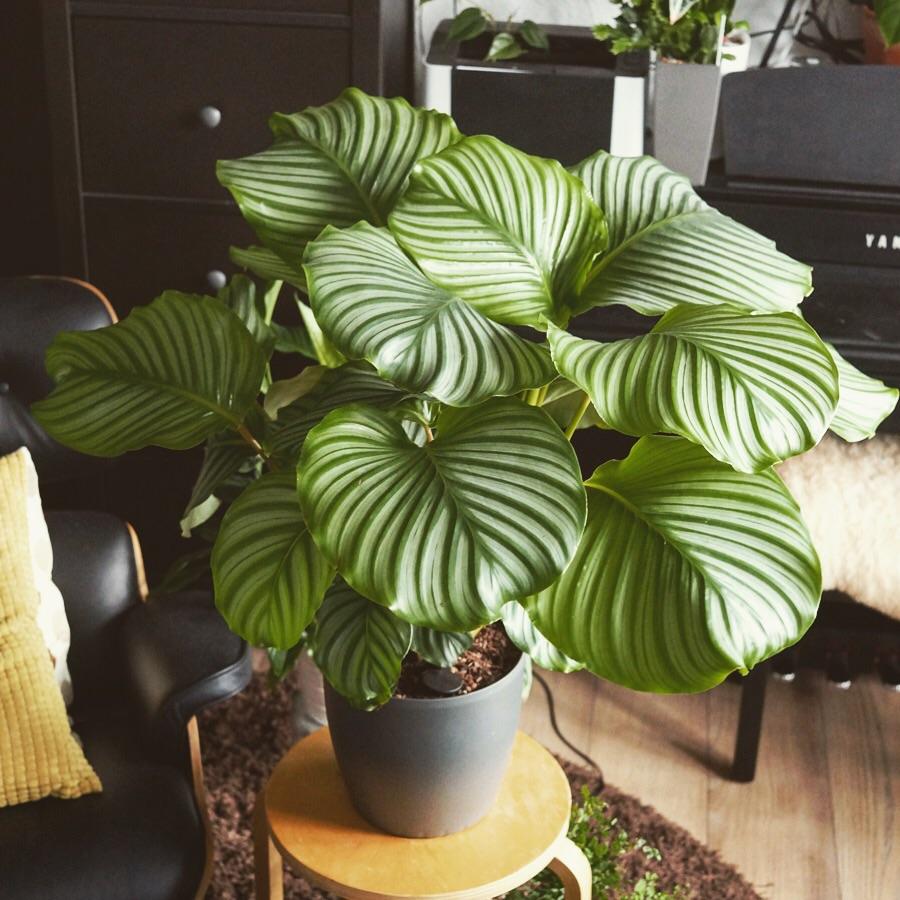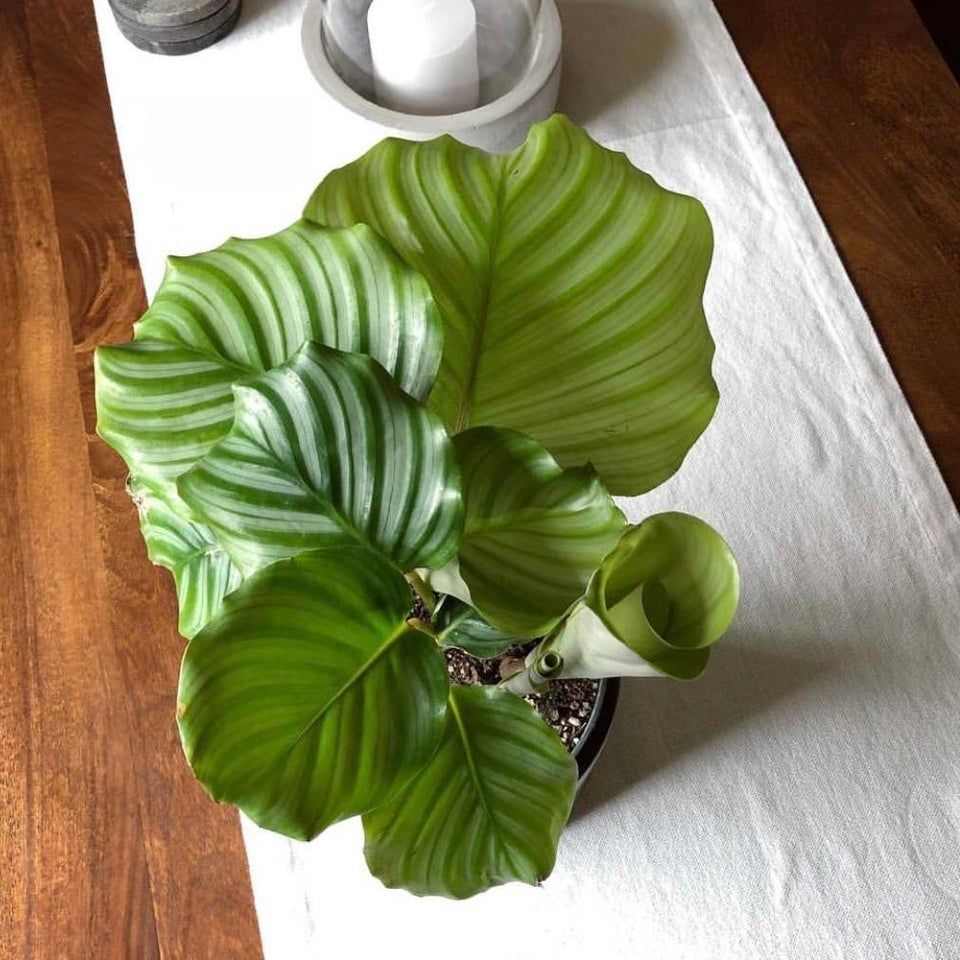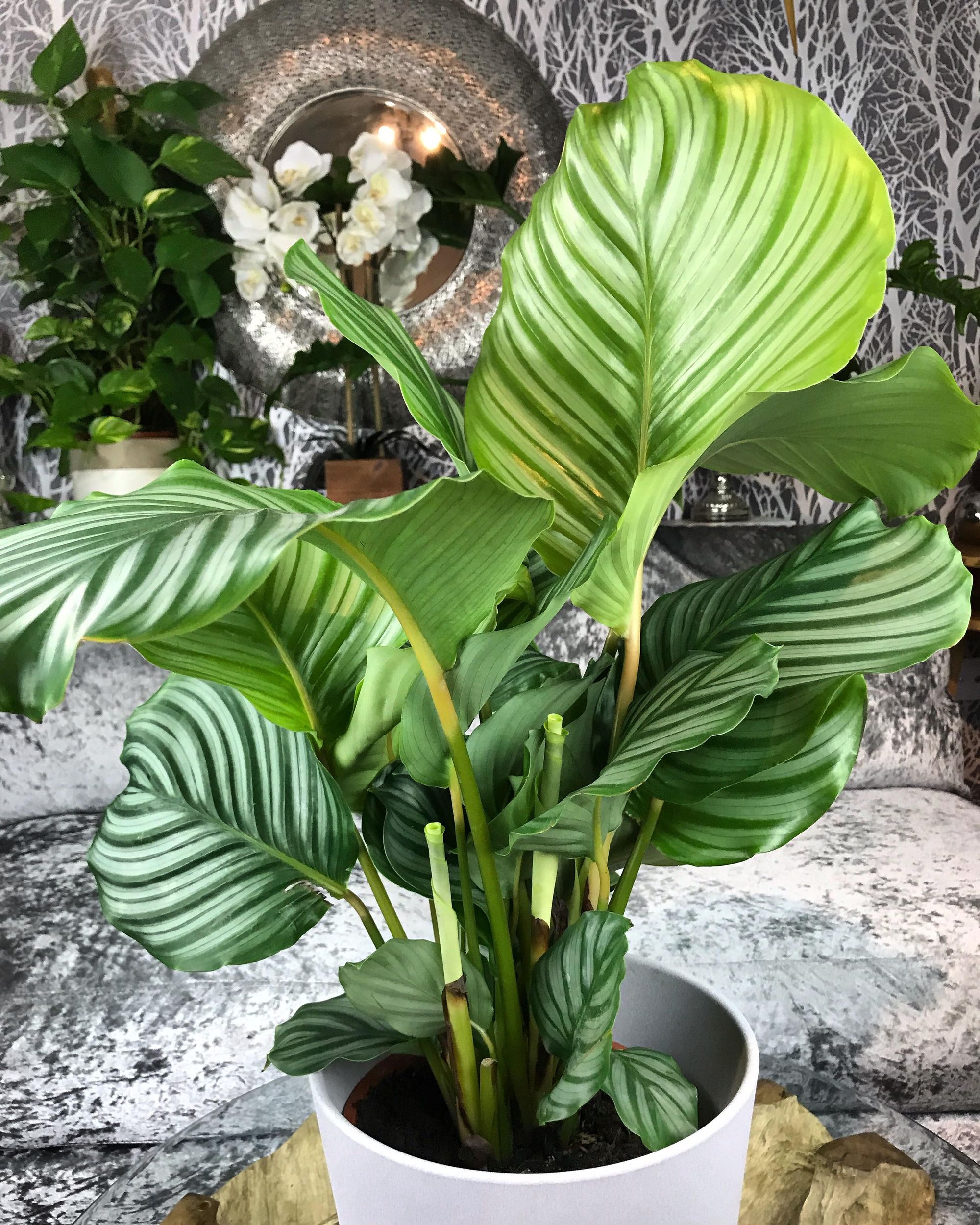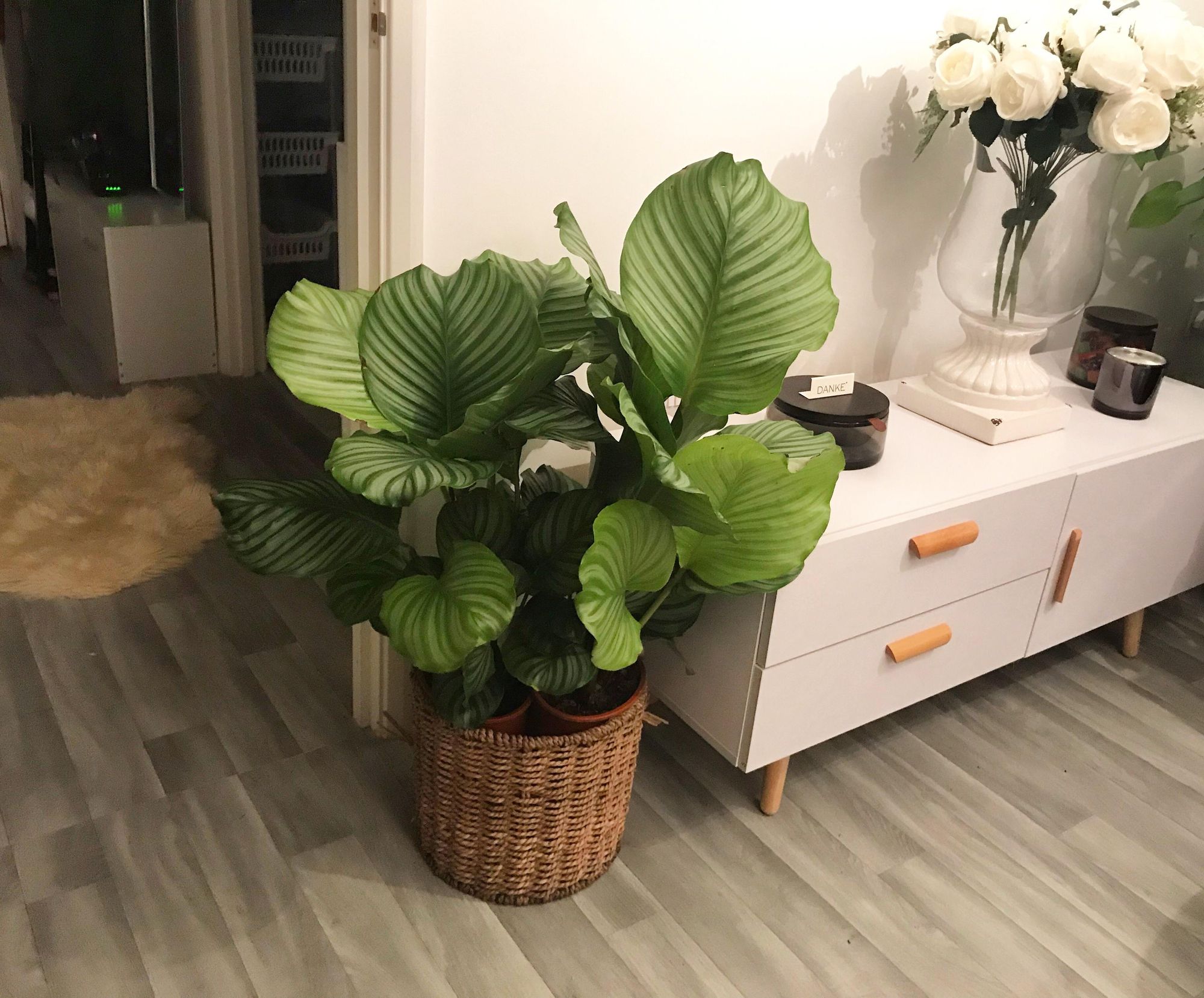Caring for Diva plants - Calathea Orbifolia
Known as a “prayer plant,” Orbifolias close their leaves at night and re-open them in the morning through a process known as nyctinasty

Updated May 2022
Mesmerizing, candy-like patterns on rich green leaves make Calathea Orbifolia captivating specimens. Their large decorative leaves are a transfixing addition to any room. Combined with their air-purifying properties, they are sought-after by many plant lovers.
From deep in the Bolivian jungles of South America, the Calathea Orbifolia is a perennial plant that flourishes in low light areas mimicking the jungle floor.
Known as a “prayer plant,” Orbifolias close their leaves at night and re-open them in the morning through a process known as nyctinasty (which is where saying “to turn over a new leaf” comes from!). This means they’re highly animated—so if you catch yourself wondering if it’s somehow moved since you last looked, don’t be alarmed. It probably has.
Despite their popularity, it’s no beginner’s plant. If you’re after something similar for your first foray into plant ownership, there are plenty of other Calathea out there. But if your heart is set on the Orbifolia, be prepared to dedicate time to caring for it. And read on.
We’ve laid out the most critical areas to pay attention to below.

What are the most important things to look out for in Calathea Orbifolia?
Here’s a top-level view of what you need to know:
- Lighting - Shaded and lower light is best. Direct sunlight can burn the leaves.
- Water - Keep your Orbifolia moist, but ensure good drainage. Avoid tap water.
- Temperature - 60 degrees is ideal. If that’s too cool for home, a little warmer is ok.
- Size - Calathea Orbifolia grows to between 2-3ft, with 30cm wide leaves.
- Diseases/Pests - Root rot is the biggest killer. They also attract a whole host of pests.
Are Calathea Orbifolia hard to care for?
Dryness, drooping and discolouration. If these words ring true for the state of your Calathea’s leaves, you’re not alone. Caring for Calathea Orbifolia is notoriously hard. They are incredibly fussy about their conditions, so caring for them can be tricky if you’re unfamiliar with what they like.
Usually, most issues can be traced back to watering and humidity, so nailing this aspect of care is vital. What water they like, how often you should water them, and how much the temperature and humidity of the room you’re keeping them in varies are factors to consider when caring for calathea.
How should you water Calathea Orbifolia?
When in doubt, natural is best. So using rainwater to quench your calathea's thirst is a good standard. Where that's not possible, distilled water is an excellent second option.
Avoid tap water at all costs—the minerals and chemicals in tap water have negative effects on the leaves (yellowing and drooping) and the general health of your plant.
Having decided what to water your plant, it's essential to know how much to give it. Overwatering should be avoided at all costs, as it leads to one of the most significant issues in Calathea Orbifolia: root rot.
Often, overwatering is caused by a lack of drainage. This usually presents itself in calathea through discolouration of the lower leaves. To avoid this, make sure your Orbifolia sits in a pot with suitable drainage holes. When you can see water trickling through those holes, stop watering.
On the other side of the spectrum, you have underwatering. Obvious indicators of this are dry, brown leaves. Often, this is linked to a lack of humidity and, if persistent, can lead to chronic issues. Sometimes this is a drainage issue caused by overly peaty soil that repels the water.
Quick tip: Grab those chopsticks that have been rolling around in your kitchen drawer for years, and give the soil a quick poke. If it comes out evenly moist, great. If not, then there's a good chance there's peat in there that needs breaking up.
What humidity does Calathea Orbifolia like?
Lastly, humidity. Calathea Orbifolia is a jungle plant and used to humid conditions. Getting the humidity just right for your calathea can be a tricky part of the caring requirements. But it's critical to your plant's health.
The sad truth however is that most of us don't live in 90% humidity households..
But the good news is that the Calathea Orbifolia will thrive at around a 70% humidity rate, which is easily achievable with a few tricks.
Here are some ways you can boost the humidity for your plant to keep it vibrant:
- Mist the leaves every 2-3 days with a spray bottle
- Group plants that like humidity together
- Stand the pot on a plate of damp pebbles
- Sit little bowls of water around the base of the plant
- Scatter seashells around the base, so they capture water during regular watering

How fast does Calathea Orbifolia grow?
Orbifolias have a moderately fast growth rate. How often you feed them and whether they are confined to a small pot size will determine how large they grow. Feeding them every 2-3 weeks during their growing season (spring to summer) is perfect.
Most Calathia Orbifolia grow to between 2 and 3 feet in height, with leaves at the top end of 30cm wide—about the size of your head. So medium in size.
If your plant is really flourishing, you may have more leaves popping up that give the impression it’s a lot larger. Because of this, how wide your plant grows is often unique to the specimen.
Can Calathea Orbifolia grow in low light?
Calathea Orbifolia is a member of the Marantaceae or “prayer plant” family. Preferring semi-shade that mimics the Bolivian jungle floor, they can tolerate low light but not direct sun.
Overly bright light will fade, and in severe cases damage, the beautiful leaves of your calathea. Naturally bright forest shade (or as close to it) is ideal.
In the home, you’ll find them responding best to light from a North-facing window or some gentle morning sun from the East. Keep them well away in a shaded corner if you’re thwarted by only South and West facing windows. If you’re unsure what low-light really is, a quick test you can do is to check if you can read in it pretty comfortably.

When should I repot my Calathea Orbifolia?
Keeping with the theme, calatheas are pretty fussy when it comes time for repotting. They just don't like it. However, if your calathea becomes rootbound, it won't grow very well.
You'll see some signs that it's time to repot if you look closely. The easiest to look out for is the crown of the plant pushing up out of the potting mix. Another way to check if it's time to repot is to pick your calathea up and check for any roots peeking out of the drainage holes. If there is, it's a sign to move it to something roomier.
Ideally, you'll want to repot every two years. Springtime is best, just as your calathea's growing season begins. When repotting, make sure to check for the ever-constant worry of root rot.
If you notice small nodules have developed along your plant's roots, do not remove them. Your calathea makes forms them to store water and nutrients for potential droughts, and getting rid of them can stress your plant.
To repot, fill your new pot (it should be one size up from the previous) halfway up with your ideal potting mix. Next, gently place in your calathea, then lightly fill the rest of the pot up with your potting mix. No need to get aggressive with packing it in tightly. Once you've completed these steps, water your calathea in.
Make sure you hydrate your plant well for 24 hours before tinkering with the root system. And once you have potted your plant, wait about a month before feeding it—they are prone to fertilizer burn after a new potting.
How do you propagate a Calathea Orbifolia?
Unlike many plants like succulents and most aroids, calatheas can’t be propagated by stem cutting. The only way you will propagate this beauty is through division—dividing the plant at the roots into several smaller plants.
If you’re planning to propagate your calathea, make sure you divide at the start of the growing season to get each division’s maximum benefit and growth potential.
What should I feed my Calathea Orbifolia?
Weak doses of nitrogen-rich foliage fertilizer once or twice a month during the growing season will help keep your calathea healthy and beautiful. But remember, if you’ve just repotted your plant, make sure to wait a month before feeding to avoid fertilizer burn.
What is the best potting soil for Calathea Orbifolia?
Excellent drainage and fertility should be your first concern for potting soil. A good mix between organic matter and perlite is perfect. A general rule of thumb for potting a new plant would be one-part perlite, one-part orchid bark, and two-parts potting soil. Organic matter like orchid bark holds moisture brilliant, while the perlite provides excellent drainage.
Peat-based soils are also good and are close to the natural earth that a Calathea Orbifolia is used to in Bolivia. Peaty soil contains essential nutrients that are critical for calatheas to thrive. But beware, if it dries too much, it can form a barrier to drainage.
Conclusion
Calathea orbifolias can be fussy, slow growing and just plain difficult to care for (like many other Calathea variety), but it's stunning leaves are so rewarding that it makes everything worthwile in the end (if you get it right ofcourse!)